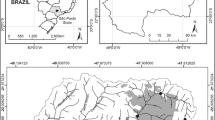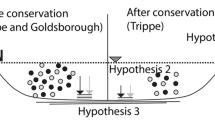Abstract
The Reedy River in South Carolina is affected by the urban area of Greenville, the third most populous city in the state, and by the effluents from two large-scale municipal wastewater treatment plants (WWTPs) located on the river. Riverine water chemistry was characterized using grab samples collected annually under spring season baseflow conditions. During the 4-year time period associated with this study, climatic variations included two severe drought spring seasons (2001 and 2002), one above-normal precipitation spring season (2003), and one below-normal precipitation spring season (2004). The influence of drought and human activities on the baseflow chemistry of the river was evaluated by comparing concentrations of dissolved anions, total metals, and other important water chemistry parameters for these different years. Concentrations of copper and zinc, common non-point source contaminants related to urban activities, were not substantially elevated in the river within the urban area under baseflow conditions when compared with headwater and tributary samples. In contrast, nitrate concentrations increased from 1.2–1.6 mg/l up to 2.6–2.9 mg/l through the urban stream reach. Concentrations of other major anions (e.g., sulfate, nitrate) also increased along the reach, suggesting that the river receives continuous inputs of these species from within the urban area. The highest concentrations of major cations and anions typically were observed immediately downstream from the two WWTP effluent discharge locations. Attenuation of nitrate downstream from the WWTPs did not always track chloride changes, suggesting that nitrate concentrations were being controlled by biochemical processes in addition to physical processes. The relative trends in decreasing nitrate concentrations with downstream distance appeared to depend on drought versus non-drought conditions, with biological processes presumably serving as a more important control during non-drought spring seasons.
Similar content being viewed by others
References
Andersen, B. C., Lewis, G. P., & Sargent, K. A. (2004). Influence of wastewater-treatment effluent on concentrations and fluxes of solutes in the Bush River, South Carolina, during extreme drought conditions. Environmental Geosciences, 11, 28–41.
Andrews, S., & Sutherland, R. A. (2004). Cu, Pb and Zn contamination in Nuuanu watershed, Ohau, Hawaii. Science of the Total Environment, 324, 173–182.
Beasley, B. R., Criss, M., Quattro, L., & Scharf, R. (2001). The Reedy River report: Managing a watershed. Report no. 22 (p. 116). Columbia, SC: South Carolina Department of Natural Resources: Land, Water and Conservation Division.
Berestov, A. L., Fernando, H. J. S., & Fox, P. (1998). Modeling of transport and seepage in effluent-dominated streams. Water Resources Research, 34, 3025–3033.
Boulton, A. J. (2003). Parallels and contrasts in the effects of drought on stream macroinvertebrate assemblages. Freshwater Biology, 48, 1173–1185.
Brooks, B. W., Stanley, J. K., White, J. C., Turner, P. K., Wu, K. B., & La Point, T. W. (2004). Laboratory and field responses to cadmium: An experimental study in effluent-dominated stream mesocosms. Environmental Toxicology and Chemistry, 103, 1057–1064.
Caruso, B. S. (2002). Temporal and spatial patterns of extreme low flows and effects on stream ecosystems in Otago, New Zealand. Journal of Hydrology, 257, 115–133.
Chen J., He, D., Zhang, N., & Cui, S. (2004). Characteristics of and human influences on nitrogen contamination in Yellow River system, China. Environmental Monitoring and Assessment, 93, 125–138.
Clark, G. M., Mueller, D. K., & Mast, M. A. (2000). Nutrient concentrations and yields in undeveloped stream basins of the United States. Journal of the American Water Resources Association, 36, 849–860.
Clawges, R. M., & Vowinkel, E. F. (1996). Variables indicating nitrate contamination in bedrock aquifers, Newark Basin, New Jersey. Water Resources Bulletin, 32, 1055–1066.
Dahm, C. N., Baker, M. A., Moore, D. I., & Thibault, J. R. (2003). Coupled biogeochemical and hydrological responses of streams and rivers to drought. Freshwater Biology, 48, 1219–1231.
Deksissa, T., Ashton, P. J., & Vanrolleghem, P. A. (2003). Control options for river water quality improvement: A case study of TDS and inorganic nitrogen in the Crocodile River (South Africa). Water SA, 29, 209–217.
Diamond, J. M., Hall, J. C., Pattie, D. M., & Gruber, D. (1994). Use of an integrated monitoring approach to determine site-specific effluent metal limits. Water Environment Research, 66, 733–743.
Ellis, J. B., & Revitt, D. M. (2002). Sewer losses and interactions with groundwater quality. Water Science and Technology, 45, 195–202.
Franklin, R. E., Duis, L., Smith, B. R., Brown, R., & Toler, J. E. (2003). Elemental concentrations in soils of South Carolina. Soil Science, 168, 280–291.
Ha, S.-R., & Bae, M.-S. (2001). Effects of land use and municipal wastewater treatment changes on streamwater quality. Environmental Monitoring and Assessment, 70, 135–151.
Herpe, Y. V., & Troch, P. A. (2000). Spatial and temporal variations in surface water nitrate concentrations in a mixed land use catchment under humid temperate climate conditions. Hydrological Processes, 14, 2439–2455.
Humphries, P., & Baldwin, D. S. (2003). Drought and aquatic ecosystems: An introduction. Freshwater Biology, 48, 1141–1146.
Jordan, T. E., Weller, D. E., & Correll, D. L. (2003). Sources of nutrient inputs to the Patuxent river estuary. Estuaries, 26, 226–243.
Karanfil, T., Erdogan, I., & Schlautman, M. A. (2003). Selecting filter membranes for measuring DOC and UV254. Journal of the American Water Works Association, 95, 86–100.
Kellman, L., & Hillaire-Marcel, C. (1998). Nitrate cycling in streams: Using natural abundances of NO3-Sigma-15N to measure in-situ denitrification. Biogeochemistry, 43, 273–292.
Kim, K., Lee, J. S., Oh, C.-W., Hwang, G.-S., Kim, J., Yeo, S., et al. (2002). Inorganic chemicals in an effluent-dominated stream as indicators for chemical reactions and stream flows. Journal of Hydrology, 264, 147–156.
Lake, P. S. (2003). Ecological effects of perturbation by drought in flowing waters. Freshwater Biology, 48, 1161–1172.
Lucey, K. J., & Goolsby, D. A. (1993). Effects of climate variations over 11 years on nitrate–nitrogen concentrations in the Raccoon river, Iowa. Journal of Environmental Quality, 22, 38–46.
Maidment, D. R. (1993). Handbook of hydrology. New York: McGraw-Hill.
Marti, E., Aumatell, J., Gode, L., Poch, M., & Sabater, F. (2004). Nutrient retention efficiency in stream receiving inputs from wastewater treatment plants. Journal of Environmental Quality, 33, 285–293.
McMahon, P. B., Tindall, J. A., Collins, J. A., Lull, K. J., & Nuttle, J. R. (1995). Hydrologic and geochemical effects on oxygen-uptake in bottom sediments of an effluent-dominated river. Water Resources Research, 31, 2561–2569.
Parr, L. B., & Mason, C. F. (2003). Long-term trends in water quality and their impact on macroinvertebrate assemblages in eutrophic Lowland River. Water Research, 37, 2969–2979.
Reilly, J. F., Horne, A. J., & Miller, C. D. (2000). Nitrate removal from a drinking water supply with large free-surface constructed wetlands prior to groundwater recharge. Ecological Engineering, 14, 33–47.
Rhodes, A. L. (2001). Influence of land use on water quality of a diverse New England watershed. Environmental Science & Technology, 35, 3640–3645.
Robson, A. J., & Neal, C. (1997). Regional water quality of the River Tweed. Science of the Total Environment, 194, 173–192.
Saunders, J. F., & Lewis, W. M. (2003). Implications of climatic variability for regulatory low flows in the South Platte river basin, Colorado. Journal of the American Water Resources Association, 39, 33–45.
Sjodin, A. L., William, M. L., & Saunders, J. F. (1997). Denitrification as a component of the nitrogen budget for a large plains river. Biogeochemistry, 39, 327–342.
Sonoda, K., Yeakley, J. A., & Walker, C. E. (2001). Near-stream land use effects on streamwater nutrient distribution in an urbanizing watershed. Journal of the American Water Resources Association, 37, 1517–1532.
Vengosh, A., & Keren, R. (1996). Chemical modifications of groundwater contaminated by recharge of treated sewage effluent. Journal of Contaminant Hydrology, 23, 347–360.
Wall, G. R., Phillips, P. J., & Riva-Murray, K. (1998). Seasonal and spatial patterns of nitrate and silica concentrations in Canajoharie Creek, New York. Journal of Environmental Quality, 27, 381–389.
Wayland, K. G., Long, D. T., Hyndman, D. W., Pijanowski, B. C., Woodhams, S. M., & Haack, S. K. (2003). Identifying relationships between baseflow geochemistry and land use with synoptic sampling and R-mode factor analysis. Journal of Environmental Quality, 32, 180–190.
Whitall, D., Castro, M., & Driscoll, C. (2004). Evaluation of management strategies for reducing nitrogen loadings to four US estuaries. Science of the Total Environment, 15, 25–36.
Author information
Authors and Affiliations
Corresponding author
Rights and permissions
About this article
Cite this article
Hur, J., Schlautman, M.A., Karanfil, T. et al. Influence of Drought and Municipal Sewage Effluents on the Baseflow Water Chemistry of an Upper Piedmont River. Environ Monit Assess 132, 171–187 (2007). https://doi.org/10.1007/s10661-006-9513-1
Received:
Accepted:
Published:
Issue Date:
DOI: https://doi.org/10.1007/s10661-006-9513-1




